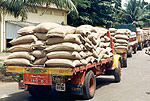|
 Theoretically
it is easier to import goods to Mumbai from abroad than
from Kolkata. And the culprit responsible for this anomaly
is the archaic sales tax system in the country. Theoretically
it is easier to import goods to Mumbai from abroad than
from Kolkata. And the culprit responsible for this anomaly
is the archaic sales tax system in the country.
Today,
if goods have to be transported from Kolkata to Mumbai
by road, they have to pass through the states of West
Bengal, Jharkhand, Orissa, Chattisgarh, Madhya Pradesh
and Maharashtra. At each state, various taxes are levied,
which increases their prices. Further, there is considerable
paper work involved, which can lead to the goods being
held up for days.
Under
the present tax regime, double tax is levied on all processed
and manufactured goods, increasing the cost of the final
product. Under the proposed value added tax (VAT), only
the value-added portions will taxed. This mechanism ensures
that the tax is neutral regardless of how many transactions
are involved
All
these and more glitches will be eliminated if the states
implement the VAT. VAT was supposed to be introduced in
April 2003 but the state government delayed enacting the
legislation as they feared loss in their revenues. Traders
also lobbied strenuously against VAT as they would be
required to keep books of accounts to claim credits under
VAT.
Today,
120 countries have embraced VAT. Their experience has
been positive. In India, Haryana implemented VAT in April
2003 and since then the state''s revenues have gone up.
However,
like all good things, all bad things must also come to
an end. That happened on November 2, when finance minister
P Chidambaram announced that 26 states have enacted legislation
to usher in the VAT regime from April 1, 2005. Three states
— Uttar Pradesh, Manipur and Nagaland — are
yet to enact the laws but the centre is negotiating with
them.
The
finance ministry has reached an agreement with state governments
over the compensation package to be availed by them to
offset possible revenue losses during the initial transition
period.
 Chidambaram
met with the finance ministers of the states and cobbled
up a formula for compensating the states if there is a
fall in their revenues. Accordingly, states would be entitled
to 100 per cent compensation for any revenue loss in the
first year, followed by 75 per cent and 50 per cent in
the second and third years, respectively. Chidambaram
met with the finance ministers of the states and cobbled
up a formula for compensating the states if there is a
fall in their revenues. Accordingly, states would be entitled
to 100 per cent compensation for any revenue loss in the
first year, followed by 75 per cent and 50 per cent in
the second and third years, respectively.
This
computation, in turn, would be worked out on the basis
of the actual annual sales tax growth rates registered
during the last five years from 2000-01 to 2004-05. Of
these five years, the average of the `best three years''
will form the reference growth rate that would be employed
for estimating the revenues that would have accrued to
the states had the existing sales tax regime continued
from 2005-06. The compensation sums would then be arrived
at, by subtracting the actual revenues flowing after the
introduction of VAT from the projected revenues taking
the reference growth rate.
Asim
Dasgupta, the West Bengal finance minister and chairman
of the empowered committee on implementation of VAT, said
that the compensation formula would be applied on a state-by-state
basis. This would mean working out reference growth rates
for each state, taking into account their actual annual
sales tax growth during 2000-01 and 2004-05 and averaging
out the best of three years individually.
Chidambaram,
on his part, held that the compensation outgo for the
centre may be nothing going by the experience in Haryana.
"In our assessment, we expect surplus revenues from
states with the implementation of VAT. So, there may not
be any requirement for compensation," he said.
The state finance ministers have also agreed that central
sales tax (CST) and the additional excise duties in lieu
of sales tax (AED) will remain in their present form till
2005-06.
In
the original plan to switch over to VAT, CST was to have
been phased out with the introduction of VAT, and Jaswant
Singh, former finance minister, had proposed halving the
rate to 2 per cent in his 2003-04 union budget.
In
order to offset the losses from the CST duty cut, the
''additional duties of excise (goods of special importance)
act'', 1957, was sought to be amended to allow states to
levy sales tax on sugar, textile and tobacco products.
Currently,
the centre imposes ''additional duties of excise'' on these
items and transfers an additional 1.5 per cent of its
tax proceeds to states in return for their not charging
sales tax on them. Under Singh''s proposal, the states
were to be given powers to levy sales tax on the three
commodities, even while they would continue to obtain
the additional 1.5 per cent devolution from central taxes.
But
none of these proposals finally saw the light of the day.
The latest decision merely reinforces the status quo till
2005-06. The 4 per cent CST rate will remain till a new
''empowered panel of state finance ministers'' re-works
the modalities for the phase-out. Thus, VAT will take
off from April 2005, even as the current CST regime stays.
While
the ruffled feathers of the state ministers have been
smoothened, it is now up to Chidambaram and Dasgupta to
rope in the traders to accept VAT. Towards this end, Dasgupta
has said that they would meet the representatives of every
trader association and council to convince them about
the benefits of VAT.
In
2003, the traders had a two-day countrywide strike, which
led to the postponement of VAT. So, Dasgupta and his team
will have to stretch their negotiating skills.
|